Gran Turismo 7 Review - Sleeping Beauty
Finally, Polyphony Digital takes us back to the future. Gran Turismo 7 recovers all singleplayer features fans loved the series for, and gives them modern look. But the game itself doesn’t feel modern at all, sadly. Forza got far away.
The review is based on the PS5 version. It's also relevant to PS4 version(s).
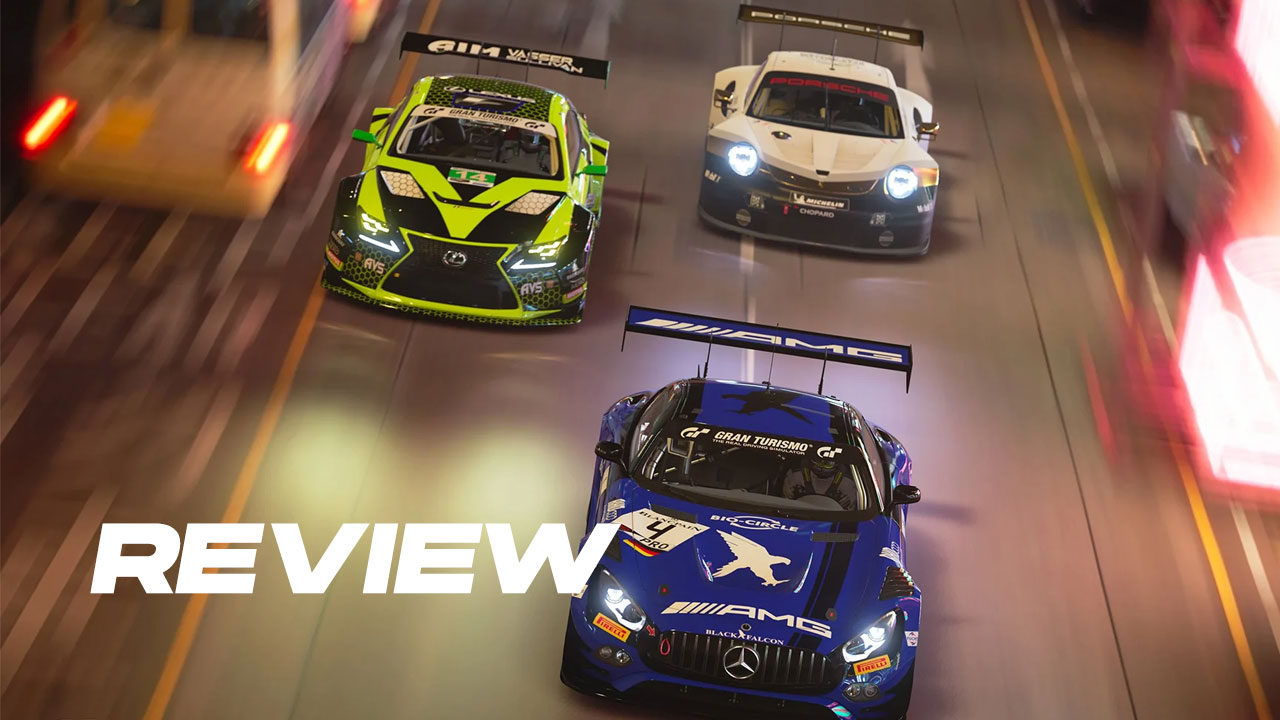
- nostalgia written all over it;
- automotive passion;
- robust career mode with licenses, car tuning etc.
- large roster of great cars to collect and modify;
- pretty graphics, especially cars;
- replays, Scapes scenes and Menu Books showcases are pure joy to watch;
- fine car audio effects and wide selection of music;
- physics are more advanced than before…
- …but don’t feel quite right on DualSense;
- grindy economics, designed for microtransactions;
- strictly linear progression;
- humdrum racing with AI;
- driving lacks immersion and sense of speed;
- poor car damage;
- annoying “talking heads” in menus.
Amidst the fronts of console wars, there is one peculiar battlefield. Sony has many brilliant exclusive games for PlayStation, but there’s a weird curse when it comes to racing games – which is the exact opposite of Microsoft’s situation. While the Redmond company has released one Forza after another, witch each installment becoming an instant hit, Sony managed to release just three major exclusives in this genre since the launch of the 8th generation. And each one disappointed on launch: first DriveClub, then Gran Turismo Sport – and now Gran Turismo 7.
The biggest flaw of GT Sport, which disappointed many fans, was lack of a full-fledged singleplayer experience. Developers from Polyphony Digital promised the upset community to make up for it in their next game – and so they did. Basically, every beloved feature from Gran Turismo 4, widely considered to be a pinnacle of series’ excellence, has been brought back, and is as enjoyable as it ever was.
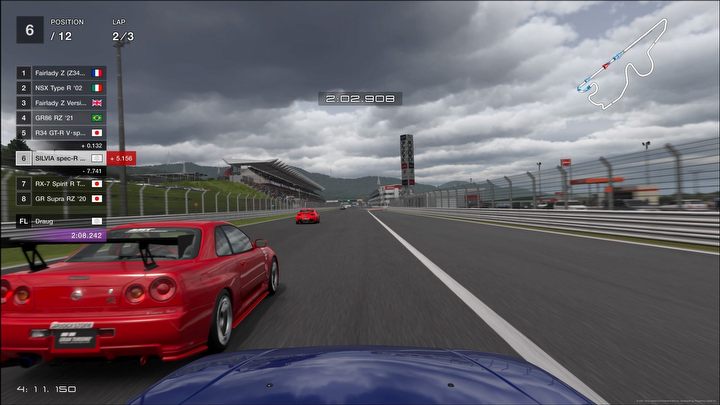
There are still only four views to pick from during race. Thankfully, you can at least tweak cockpit and chase cams a little to your liking.
However, seventeen years have passed since the release of GT4 and devs understood that they must make this traditional career mode more accessible and clearer for the younger generation of players. So, they focused their attention on adding additional layer of explanation to every single element of the game, as well as on keeping players safe from feeling overwhelmed with all that content and features, thrown at them all at once. In other words, Polyphony Digital strictly limited player’s choice. And that’s the fundamental flaw in the Gran Turismo 7’s design.
Linearity, grind & microtransactions
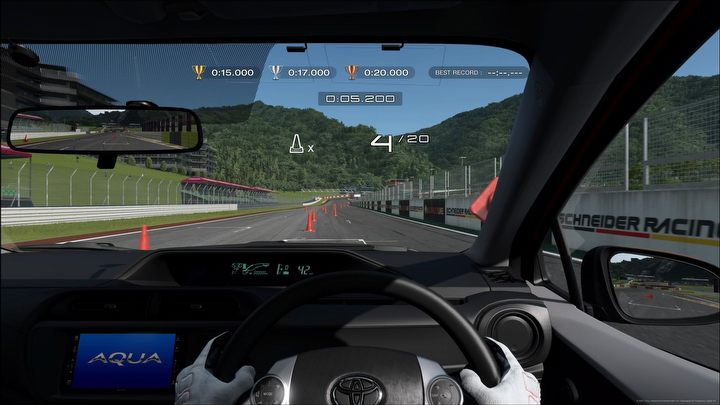
Cockpit view became slightly more immersive than before thanks to some additional shakes, but it's still far from what other games offer. I'd like to be able to move the camera further from the windshield for starter.
There’s bad news if you are you an experienced driver who’s mostly interested in multiplayer racing (especially in the Sport mode, which has your rank/level imported from GT Sport). You can’t jump on the track right away. You must play for several hours and complete a dozen or so races before you unlock the online mode. If you want to customize the looks of your car, it will also have to complete a dozen or so races. Heck, you can’t even access the photo mode or the autoshow (Brand Central) until you do some racing and other tasks.
“Tasks” is the key word here. The central spot on the world map, which serves as a main menu (just like in the classic Gran Turismo games), is the Cafe. You’ll visit it regularly to accept and complete so-called Menu Books. These are sets of goals to achieve appointed to you by some guy called Luca who wants you to discover all features in the game step by step. Usually the goal is to collect three specific cars – and so it turns out that there are three specific races rewarding you with these particular vehicles. And when you catch ‘em all Luca will recount their story. Cool, right?
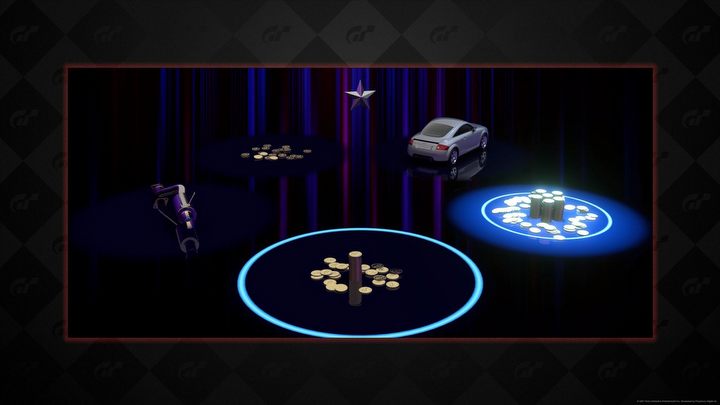
I was eager to play GT Sport every day just to complete the daily workout and get another car. Roulettes in GT7 don't give me the same motivation.
Sadly, this isn’t actually very cool. There’s a reason why every modern racing game makes sure to leave players with as much choice as possible, providing them with various car classes or events to try. Gran Turismo 7 disregards such an approach and prefers a strictly linear way of progression through the career mode. So what the game brings 420+ cars, if it at the same time requires you to drive Japanese compacts first, then European classic microcars, then other Japanese cars again, and so on. Do you simply want to pick your favorite model and take it for a spin on Nordschleife? Forget it. You’ll have to complete dozens of Menu Books before you unlock this track. And as for picking your favorite cars…
I’m going to watch closely what happens with GT7 after the release, and I’ll be happy to hop back in once Polyphony Digital figures out the fans’ complaints and addresses them properly. Gran Turismo 7 has potential to become a truly great game one day, but it’ll require hard work from the devs.
Gran Turismo 7 incorporates a conservative model of game economy. If you want to obtain a specific car, you have to buy it. There’s no renting and not even an arcade mode with a selection of high-tier machines to fool around in (previous GT games had such feature). A Ferrari 250 GTO, for instance, requires many hours of grind (as well as waiting until the car shows up at Legend Cars dealership). But don’t fret, there’s another way, of course! Just visit PlayStation Store and get credits for real money…
Unfortunately, Polyphony Digital is bringing back the most controversial feature from Gran Turismo 6, and once again bends the game’s design so that you’d be eager to consider reaching for your wallet. You want more proof? Here you go, the daily workout (a fun feature introduced in GT Sport) has been “downgraded” and no longer guarantees you a random car every day after driving more than 42 km. Now you get a roulette coupon, with only 20% of chances to get a car. I’ve used more than a dozen such coupons and I was getting 2k or 5k credits every time. It was more of a mockery than rewarded.
What year is it?
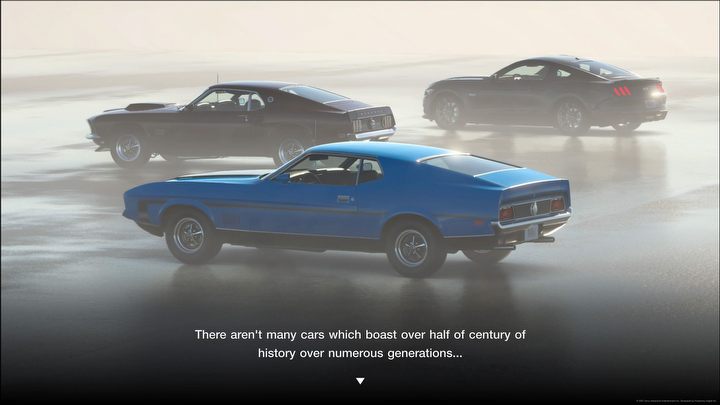
Menu Books could be a very cool feature if only Polyphony Digital let us choose the order of completing these "quests".
Explaining every part of the game is not a bad idea, but the devs took a misguided approach to it. Earlier I mentioned Luca. He’s one of the numerous characters who “populate” the world of Gran Turismo 7, and each of them have so many things to tell you. Probably too many. What’s worse, the game contains no voice-acting whatsoever, so you’re getting all the information through old-fashioned bubbles with text. After each line, you also need to click to advance these conversations, and that quickly becomes a nuisance. Especially that you must do this even after nearly every single try in every single license test.
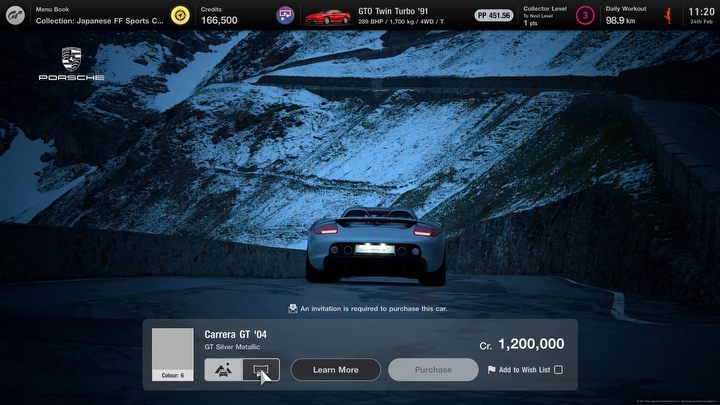
Getting money is not everything. Even some cars in the Brand Central are locked unless you have a special (timed) invitation to purchase one of them.
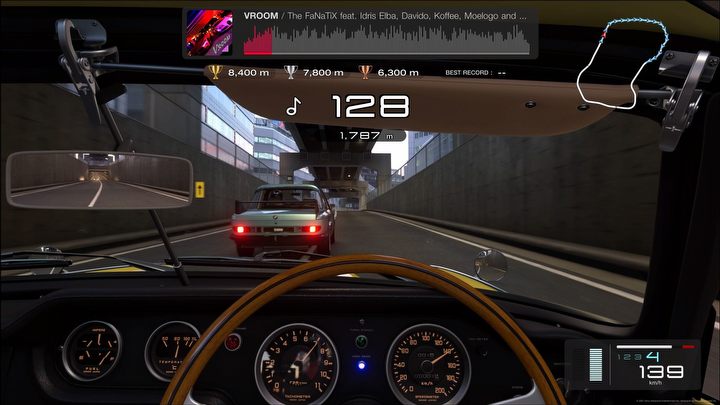
Music Rally was announced as an exciting new form of challenge, but this is essentially just another name for a classic arcade racing with time running out.
The term “old-fashioned” applies to other, much more important aspects of the game. First, racing with AI is barely fun. Virtual drivers are still glued to the ideal racing line and very reluctant to react to your presence near them. They can push you out of the road simply because you crossed their path. Moreover, even on Hard difficulty level they tend to drive slower than you despite using faster cars. However, they start every race far ahead, so catching up with them during just two or three laps may prove difficult if you don’t upgrade your machine. Truth be told, it feels more like an obstacle course than actual racing.
Another thing is the HUD, which is overloaded with information (for instance, the track map is shown in two places on the screen). However, the real issue here is that you can’t freely adjust the UI to your liking. There are merely three options: full HUD, halved or fully hidden. Furthermore, controls settings are very rudimentary (even for steering wheels) and there’s still no way to change the FOV, so the sense of speed is underwhelming. Not to mention such oversights as inability to regulate sound when in-game, or lack of any accessibility features. I’m also very upset with the removal of con markers before corners as an immensely immersive substitute for a standard racing line. Immersion in general is hardly found in Gran Turismo 7.
The bright side
So far, I was pointing out the issues, but I want to stress that GT7 is not a bad game per se. As I mentioned earlier, the traditional features within the career mode are as enjoyable as they ever were. Apart from racing, you can also engage in license tests or special missions, and striving for gold in diverse challenges, improving times or trying different approaches, is pleasant and satisfying. These are varied, fun activities.
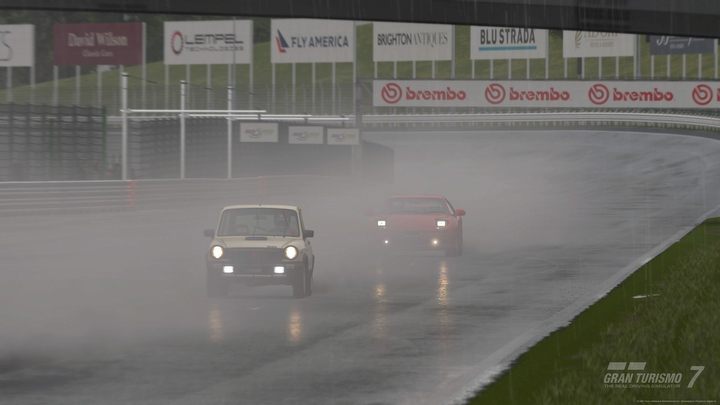
Polyphony Digital put so much attention to night sky simulation and dynamic changes of time and weather, but they forgot to make convincing rain effects when driving.
Menu Books themselves are amusing as well, despite everything. I loved watching these delightful showcases of perfectly detailed cars and learning their history. In fact, I was waiting for a similar feature in a racing game for a very long time. It shows Polyphony Digital’s deep passion for automotive industry, and I wish Turn 10 Studios or Playground Games finally presented something similar in the next installment of Forza series.
Looking at Gran Turismo 7 in general is a great pleasure. Perhaps the most generous reward after finishing a race are not credits and cars, but the possibility to watch the replay and listen to the music (especially with the new, music replay option that matches dynamic cameras with the rhythm). They look fabulous, making great use of ray tracing. The same goes for the animated scenes from the Scapes (traditional Gran Turismo photo mode).
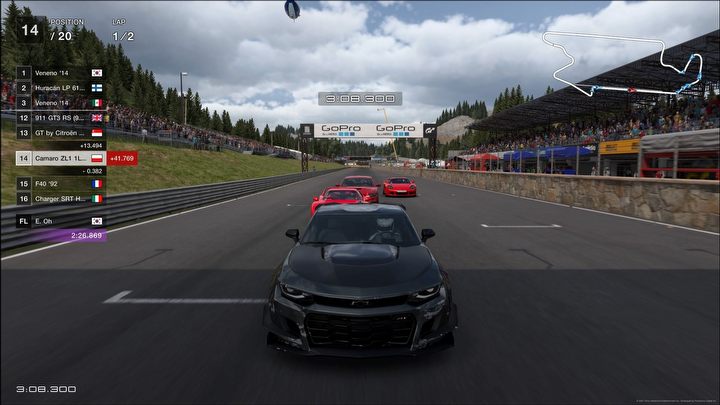
Believe it or not but that's how looks the car after some heavy beating. Damage is barely noticeable (visually as well as mechanically).
Also, enthusiasts of tuning are in for a treat in Gran Turismo 7. Purchasing (or getting as reward) one of 424 cars is just the beginning. You can then go to the tuning shop and buy dozens of parts, tweaking the vehicle’s performance in a variety of ways (you can adjust it on the advanced car settings screen). There is also good, old GT Auto which allows you to change oil, wash the car, and customize its looks by repainting the body or creating your own livery. Spoilers, bumpers and other parts can be swapped as well. All in all, Gran Turismo 7 offers greater possibilities in terms of modifying cars than Forza.
And, finally, there’s the driving itself. Polyphony Digital tweaked the car physics further than I expected, bringing it a few steps closer to the term “simulator”. Handling powerful RWD vehicles requires much more focus than in GT Sport. Even those with smaller power output, like ’89 Mazda MX-5, are now eager to react with vicious oversteer if treated carelessly. It’s great fun, if you enjoy that sort of challenge in racing games.
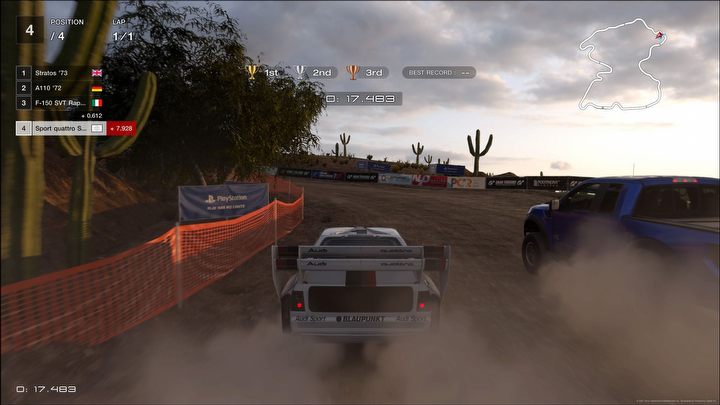
Dirt racing is still present in GT7 to some small extent, but it's obvious that Polyphony Digital doesn't intend to develop it any further.
However, a steering wheel is recommended to take full advantage of these upgrades to the simulation. Regrettably, support for DualSense’s features, praised so many times by Polyphony Digital in promo materials, is another disappointing element of Gran Turismo 7. While triggers are doing a good job, informing you about front wheels locking during braking or understeer appearing on corners (in FWD cars), potential of the gamepad’s haptic feedback has been largely untapped.
Vibration should help you notice when the rear wheels are losing traction and give you time to react and counter, but there’s no such communication between you and the machine. As a result, you’re going to need some time and practice until you learn RWD car’s handling and can cope with the oversteer.
MULTIPLAYER?
Due to limited number of players having access to Gran Turismo 7 prior to release, I was unable to fully test the multiplayer mode. However, since Polyphony Digital is importing the tried Sport component in its entirety from Gran Turismo Sport, it’s safe to assume that online racing, with the efficient system of driver ranks and penalties for unclean maneuvers, will be as praiseworthy as it was in the previous installment of the series.
Forza killer? Doubtful
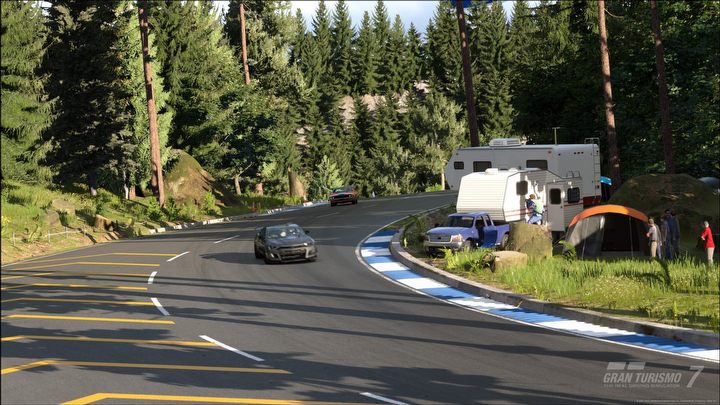
Gran Turismo 7 has 97 layouts of tracks in 34 locations. New ones, like Trial Mountain and Deep Forest, look considerably better than those imported from GT Sport.
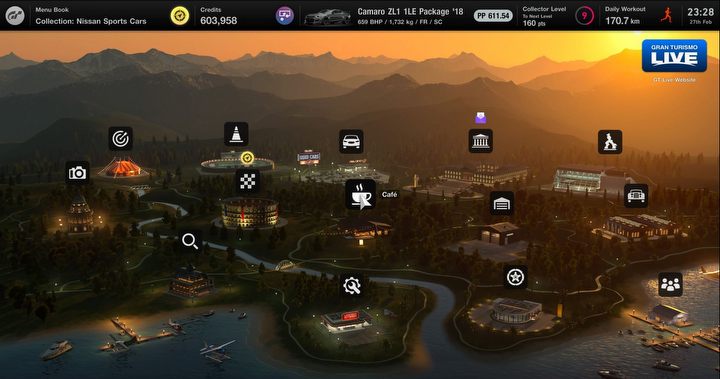
Main menu looks nice and made me feel nostalgic, but I preferred the compact design of UI from GT Sport, with this enchanting "slideshow" in the center of the screen.
Let’s sum things up. Polyphony Digital seems to live in an alternate timeline than the rest of racing games developers. Although they keep Gran Turismo up-to-date in terms of graphics or latest car models for players to choose from (at least the Japanese ones…), they don’t care about progress in other fields. On one hand, this anachronic approach gives Gran Turismo 7 a certain charm and creates a unique atmosphere. On the other, it just isn’t as entertaining as it could be.
I suppose we can expect repeating the history of GT Sport to some extent. Polyphony Digital will collect feedback from the community (it’s likely going to be harsh in some points, especially concerning microtransactions and ridiculously unrewarding roulette) and tweak the game with many updates to come. I suggest restraining from getting the game at launch and waiting to see what major changes developers are going to make in order to appease fans. They were able to add many singleplayer features to Gran Turismo Sport in response to crushing criticism, so I suspect there are many options on the table.
Personally, having this review finished, I’m glad I can finally put Gran Turismo 7 aside and return to Forza Horizon 5, where driving is a blast, the amount of activities to choose is enormous, immersion is unhindered and racing with AI is not so bad after all (not to mention the advantage of open-world over repetitive racetracks). However, I’m going to watch closely what happens with GT7 after the release, and I’ll be happy to hop back in once Polyphony Digital figures out the fans’ complaints and addresses them properly. Gran Turismo 7 has potential to become a truly great game one day, but it’ll require hard work from the devs.
Gran Turismo 7
Gran Turismo 7 Review - Sleeping Beauty
Finally, Polyphony Digital takes us back to the future. Gran Turismo 7 recovers all singleplayer features fans loved the series for, and gives them modern look. But the game itself doesn’t feel modern at all, sadly. Forza got far away.

